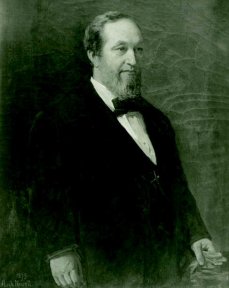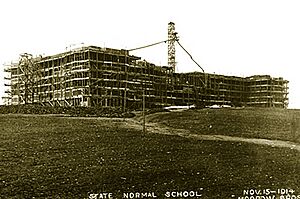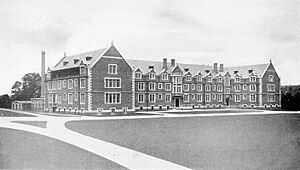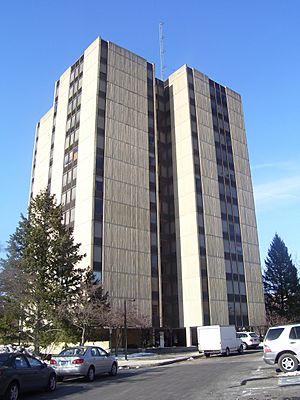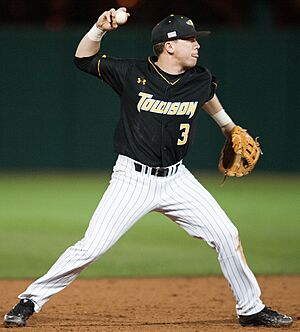Towson University facts for kids
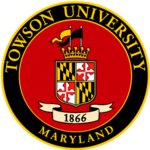 |
|
|
Former name
|
Maryland State Normal School (1866–1935) Maryland State Teachers College at Towson (1935–1963) Towson State College (1963–1976) Towson State University (1976–1997) |
|---|---|
| Type | Public university |
| Established | December 8, 1866 |
|
Parent institution
|
University System of Maryland |
|
Academic affiliations
|
|
| Endowment | $87.8 million (Towson University, 2019) |
| Budget | $540 million |
| President | Mark R. Ginsberg |
| Provost | Melanie Perreault |
|
Academic staff
|
1,644 |
| Students | 22,294 |
| Undergraduates | 18,807 |
| Postgraduates | 3,478 |
| Location |
,
United States
39°23′40″N 76°36′30″W / 39.39444°N 76.60833°W |
| Campus | Suburban, 329 acres (1.33 km2) |
| Colors | Black and Gold |
| Nickname | Tigers |
|
Sporting affiliations
|
|
| Mascot | Doc the Tiger |
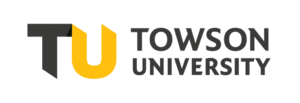 |
|
Towson University (also called TU or Towson) is a large public university in Towson, Maryland, USA. It started in 1866 as Maryland's first school for training teachers. Today, Towson University is part of the University System of Maryland.
The university has grown a lot since it began. It now has eight different colleges and more than 20,000 students. Its campus is about 329 acres, which is like 250 football fields! It's located in Baltimore County, Maryland, just eight miles north of downtown Baltimore. Towson is one of the biggest public universities in Maryland. It also trains the most teachers in the state.
Contents
How Towson University Started
Towson University has a long and interesting history. It began as a school to help people become great teachers.
The First Teacher Training School
In 1865, the state of Maryland decided to create its first school for training teachers. These schools were called "normal schools" back then. On January 15, 1866, this new school opened. It was named the "Maryland State Normal School" (M.S.N.S.).
The school first opened in Baltimore, Maryland, on North Paca Street. It started with only eleven students and three teachers. McFadden Alexander Newell was the first principal. He also served as the State Superintendent of Public Instruction. The first group of sixteen students graduated in June 1866.
The school quickly became very popular. It soon needed more space. In 1873, it moved to a new temporary spot on North Charles and East Franklin Streets. The state then gave money to build a special building for the school. In 1876, the school moved again to this new building in West Baltimore. By then, it had 206 students.
Moving to a New Campus in Towson
As the years passed, Maryland needed even more teachers. The school in West Baltimore was not big enough. Principal Sarah Richmond, who was one of the first eleven graduates, worked hard to find a new, larger campus.
In 1910, a special committee was formed to find a new location. They looked at many places. Finally, they chose an 80-acre site in Towson. In 1912, the state approved $600,000 for the move. Construction began in 1913 on the main building, which is now called Stephens Hall. In September 1915, the new campus opened. It included Stephens Hall, Newell Hall, and a power plant.
Growing and Changing Names
In 1934, the state decided that all new public school teachers needed a Bachelor's degree. Before this, they only needed a two-year certificate. So, the school changed its programs to offer these degrees. The next year, in 1935, the school's name changed to Maryland State Teachers College at Towson.
At first, the college only trained teachers. But in 1946, it started offering other college courses. This was the beginning of its art and science programs. In 1958, the college began offering its first graduate degree. By 1960, the art and science programs grew into full four-year courses. Because of these changes, the school's name changed again to Towson State College.
In the mid-1960s, many more students started going to college. Towson State College grew very quickly. Its student numbers jumped from about 3,500 to over 13,000 in ten years! This growth led to many new buildings, like the Center for the Arts and the University Union. In 1976, the school's name changed one last time to Towson State University.
In 1988, Towson joined the new University System of Maryland. Then, on July 1, 1997, the university officially dropped "State" from its name. It became simply Towson University. This new name showed how much the university had grown and changed.
Academics at Towson
Towson University is a respected school. It is approved by important education groups. For students who started in Fall 2010, Towson accepted about 57% of those who applied. The average grade point average (GPA) for new students was 3.45.
Towson has many different study areas. It teaches students in thirty departments, which are grouped into eight colleges:
- College of Business and Economics
- College of Education
- College of Health Professions
- College of Liberal Arts
- Jess and Mildred Fisher College of Science and Mathematics
- Towson University Honors College
- College of Graduate Studies and Research
- Towson University College of Fine Arts and Communication
- This college includes departments for Art, Dance, Electronic Media and Film, Mass Communication, Communication Studies, and Performing Arts. It also has the Asian Arts & Culture Center.
What Can You Study?
The university offers 110 different majors for undergraduate students. It also has over 80 graduate degrees and special certifications. Some popular programs at Towson include business, computer science, and nursing. Once students pick what they want to study, they become part of that academic college.
Towson also has a special program called gerontology. This program studies aging and older people. It is one of only about 100 such programs in the United States.
Students at Towson
Almost 20,000 full-time and part-time students attend Towson University. This includes over 800 students from 100 different countries. In 2023, Towson welcomed its largest group of first-year students ever, with 3,047 new freshmen.
There are about 3,115 staff and teachers at Towson. This means there are about 15 students for every teacher. The average class size is 24 students.
About 60% of Towson's students are female. The student population is also very diverse. About 42% are White, 30% are Black or African American, 10% are Hispanic, and 7% are Asian.
Student Life
Towson University offers many things for students to do and places to live.
Where Students Live
About 74% of new students live on campus. In total, over 5,000 students live in the university's housing. Towson has 16 residence halls. These include apartment buildings, tall modern towers, and smaller traditional buildings. Students can also join special "Residential Learning Communities." While living on campus, students can get help from a counseling center, an academic advising center, a health center, and a career center.
Getting Around Campus
Towson University has its own free shuttle bus system. These shuttles travel to most parts of the campus. There are also shuttles that go to nearby housing complexes where students live. Students can also easily use the MTA Maryland buses to connect to the light rail system.
Campus Police
The Towson University Police Department (TUPD) keeps students, teachers, and visitors safe. They are the main police force on campus and nearby streets. The Baltimore County Police Department also helps them when needed. The TUPD has different teams, like the Patrol Unit and the Community Crime Reduction Unit. They also handle emergency calls.
Campus Buildings and Plans
Towson University's campus is always growing and changing.
Campus Master Plan
The university has a "Campus Master Plan" to guide its growth. This plan helps decide where new buildings will go. It also helps make sure the campus connects well with the Towson community. The plan includes over 70 different goals. These goals range from having more diverse students to getting students involved in community service.
Many new buildings have been built as part of this plan. These include academic buildings, student life centers, roads, and parking areas.
| Name of Project | Cost | Completion Date | Description |
|---|---|---|---|
| Union Third Floor Conference Rooms | $760,000 | August 2006 | New meeting rooms for student groups in the University Union. |
| Cook Library Lobby Renovation and Starbucks Cafe | $1 million | September 2006 | The library lobby was updated, and a Starbucks Cafe was added. |
| Childcare Center | $4.5 million | January 2007 | A new building for the university's Childcare Center. |
| Towsontown Garage Expansion | $10.6 million | December 2007 | Added 500 more parking spaces for students, teachers, and visitors. |
| West Village Housing – Phase I | $36 million | Fall 2008 | Added 668 new beds for students in the West Village area. |
| College of Liberal Arts – Phase I | $51.5 million | April 2009 | The first part of a new academic building for the College of Liberal Arts. |
| College of Liberal Arts – Phase II | $72 million | Summer 2011 | The second part of the College of Liberal Arts building. |
| West Village Housing – Phase II | N/A | Summer 2011 | Two more residential buildings with 651 beds for students. |
| West Village Commons | $30 million | Summer 2011 | A building with dining, shops, and student services in West Village. |
| West Village Parking Garage | $27 million | Summer 2011 | A six-story parking garage with 1,500 spaces. |
| Campus Gateway | $11 million | Winter 2012 | A new main entrance to the campus near Burdick Hall. |
| TU Arena | $65 million | Summer 2013 | A large arena with over 5,200 seats for sports and events. |
| West Village Housing – Phase III and IV | $85 million | Fall 2016 | Two new residential buildings, Marshall Hall and Carroll Hall, with 700 beds. |
| Burdick Hall Renovation | $42 million | Winter 2018 | The recreation center was expanded with new courts, studios, and fitness areas. |
| University Union Renovation and Expansion | $96 million | Spring 2022 | The University Union was expanded with an auditorium, ballroom, and new dining spots. |
| Institute for Well Being | $60 million | Fall 2023 | A new building for health and wellness programs, including centers for hearing, autism, and speech. |
| College of Health Professions | $175 million | Summer 2024 | A large new building for the College of Health Professions with classrooms, labs, and simulation rooms. |
Being Green on Campus
Towson University cares about the environment. In 2007, the university promised to become "carbon neutral" by 2050. This means they want to balance the carbon they release with the carbon they remove. They have already cut their greenhouse gas emissions by 48%.
The university recycles 44% of its waste. They also have trayless and strawless dining halls. There are 4,000 solar panels, 36 electric vehicle charging stations, three green roofs, and two bike-sharing programs on campus.
Towson Sports Teams
The sports teams at Towson University are called the Towson Tigers. They used to be known as the Towson College Knights. All of Towson's main sports teams compete in the Colonial Athletic Association (CAA). There are 20 Division I athletic teams, including 13 women's sports and 7 men's sports.
Towson University has the most sports programs in the Baltimore area. Since joining the CAA in 2001–02, the Tigers have won many championships. These include titles in men's and women's lacrosse, swimming, men's soccer, men's golf, baseball, track & field, and football. Many Towson athletes have gone on to play professionally.
The Towson Tiger Mascot
The tiger became Towson's official mascot in 1962. Before that, the teams were called the "Towson College Knights." A student named John Schuerholz helped make the change happen. He later became a famous general manager and president for the Atlanta Braves baseball team. Towson's baseball field is named after him.
There is a bronze tiger statue outside Stephens Hall. It was put there in 2007. The university hopes it will help boost school spirit. The new statue is made to be very strong so it won't get damaged.
Fun Traditions
Tigerfest
Tigerfest is Towson University's big annual spring festival. It has fun activities for students and live music concerts. Tigerfest happens in late April. It used to be held in Johnny Unitas Stadium. Since 2014, it has been held in Towson's TU Arena. The festival now lasts for two days. The first day has games and events on campus. The second day is for the big concert. Many famous artists have performed at Tigerfest.
Helping the Community
Towson University works with the community in many ways.
Division of Economic and Community Outreach
This group helps connect the university's experts with the outside community. They offer help in areas like IT solutions, mapping, training, and business growth.
Cherry Hill Learning Zone
This program is a partnership between Towson University, the Baltimore City Public Schools, and the city government. They work together to help rebuild the Cherry Hill neighborhood in Baltimore. The program aims to support the education of young people and improve the community.
Baltimore Urban Debate League
The Towson Speech and Debate team works closely with the Baltimore Urban Debate League. They often volunteer to judge and help run debate tournaments. Towson University also hosts these tournaments at least once a year. The university offers a special scholarship called the "Urban Debate Scholar" award. It pays for full tuition and fees for one graduating high school senior each year.
Adopt-A-Campus
This program lets local businesses and groups help keep the Towson campus beautiful. Each group is given a section of the campus to help keep clean.
Media and Publications
Towson University has its own student-run media.
| Television | Radio | |
|---|---|---|
|
|
|
Greek Life
Towson has over 20 Greek letter organizations, like fraternities and sororities. In 2022, about 7% of undergraduate men and 6% of undergraduate women were part of these groups.
Famous People from Towson
Many notable people have attended or worked at Towson University.


